Why The Verge?
The Verge is the perfect example of successful content expansion. The Verge is a technology news site and it was founded by SB Nation which was a sports blogging network. Most business pundits would say that it’ll be a tough task for a sports-based publisher to succeed in a tech-based niche, The Verge Proved it to be wrong. It won 5 Webby Awards just after a year of its launch.
Additionally, the editorial team of The Verge came out from Engadget which was one of the biggest technology news sites of the time. When The Verge started, Engadget was attracting traffic in millions of page views. It was also backed by the mighty AOL (now Verizon Media) which had HuffPost and TechCrunch in its portfolio too. And now, The Verge stands tall with more than 70 million pageviews ) versus Engadget’s 66 million pageviews .
Now as the skyrocketing growth of The Verge is evident, it is worth knowing how it reached where it is today. Let’s dig deeper.
Table of Contents
How it all started?
The story of The Verge started long before its birth in 2011. It starts with AOL and Engadget.
Jim Bankoff, the current CEO of Vox Media, started his career with AOL in the mid-1990s. By the year 2002, he became the EVP for Programming and Products. His focus was on the digital content business and he wanted to shift the company over to a more ad-driven model. This was the time when AOL was an Internet Service Provider company whose major source of revenue was coming from dial subscriptions.
Still, Bankoff kept working towards his vision. In 2005, he acquired Weblogs Inc, which was the parent company of Engadget and dozens of other popular sites. He also started TMZ and FanHouse, both of them were successful ventures. Engadget also started ruling the roost of gadget sites.
But as the leadership changed, Bankoff started feeling that he was unable to pursue his vision. Hence, he left AOL in 2007. By 2008 he became an angel investor and a consultant for a small company called SB Nation. By the end of the year, SB Nation raised $5M in its first round of funding and Bankoff took the lead as a CEO in early 2009. His vision of building a media empire was back on track.
Meanwhile, in AOL, the editorial team of Engadget was also upset with “The AOL Way” of growing the company. The TechCrunch CEO was escalating the situation further. Ultimately, the Editor-in-Chief of Engadget, Mr. Joshua Topolsky along with some of his top editors and writers, left AOL. In his blog post, he confirmed that he is leaving AOL to join the SB Nation team to build a technology news site. Ultimately, The Verge was born.
The Verge attracted 4M active users in the first month, who cumulatively generated 20 million page views with a team of 30 (Src).

Where are they today?
The Verge has attained massive success across all platforms. On social media, it has 2.6M followers on Twitter, 3.5M fans on Facebook, 1.4M followers on Instagram. On YouTube, The Verge has gained close to 3M subscribers with its reviews and informational content.
30% of its 50M visitors come directly to the website, it speaks a lot about its brand value. The organic visits account for 60%, making ‘search’ as its biggest source of traffic . With almost 100 employees working for it, The Verge is estimated to make $25M in annual revenue .
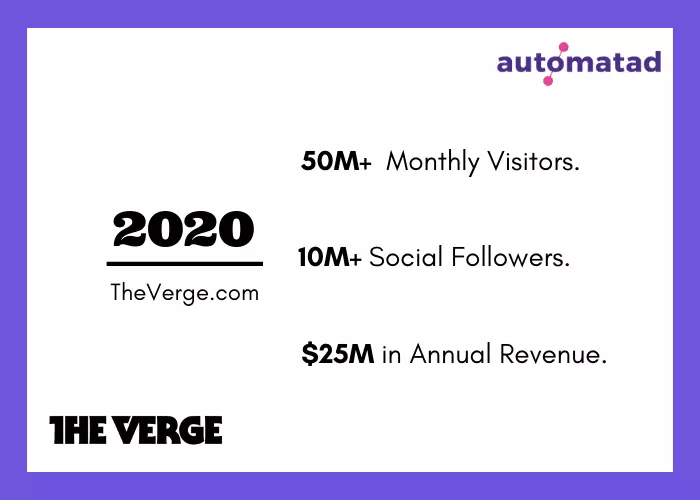
Becoming The Verge
Building the Foundation
(2011-2013)
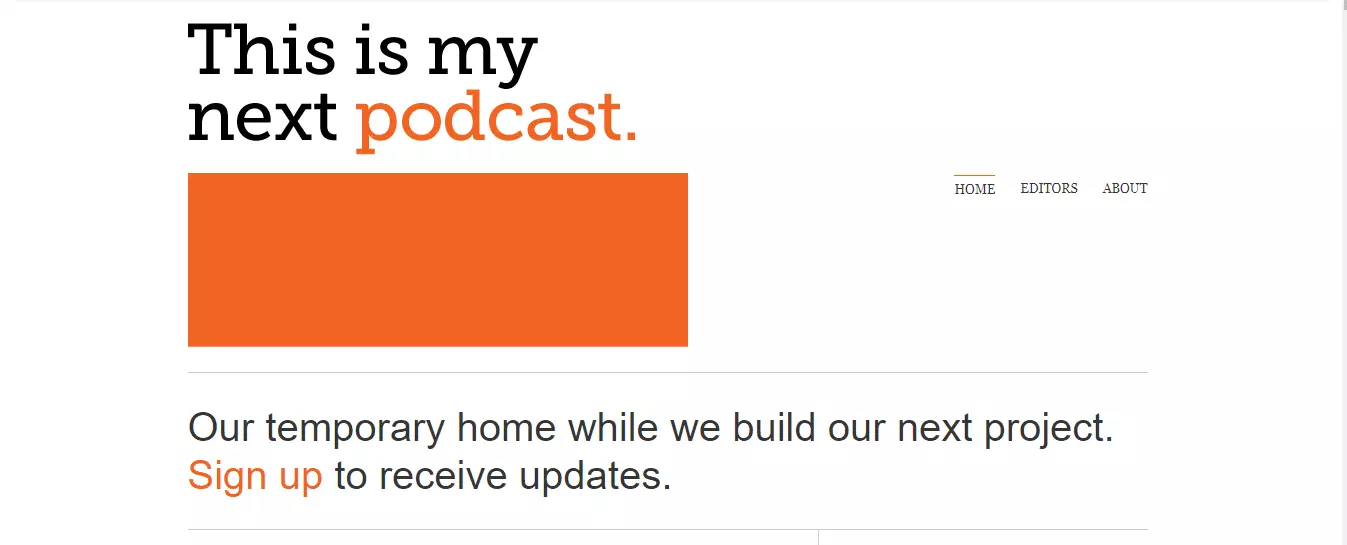
This Is My Next blog before The Verge was launched
Holding the audience
The team of editors that left Engadget to form The Verge already had a fan following in the tech world. Its editors also used to host the Engadget Podcast. Since the audience was already there, leaving it in a void was not a great idea. But The Verge was yet to be launched. So the team started a blog and a podcast in the interim. It was called This Is My Next. The podcast was hosted on the same blog.
By August 2011, the blog was garnering 1M unique visitors and 3.4M page views(Src). By October the visits reached 3M and pageviews reached 10M (Src). The Time Magazine enlisted This Is My Next among the best blogs in 2011 (Src). The popularity of the blog acted as a propellant for sending The Verge in an upward trajectory even before it was launched.
But how did they make it possible in such a small period? Well, the former Editor in Chief of The Verge Mr. Topolsky, gives all the credit to the power of social media. In an interview with Say Magazine’s summer 2012 edition, he said, “Our only promotion engine for This is my next when we left was just all tweeting. And it worked. We were as surprised as anybody.”
The loyal readers of the top journalists from Engadget, the huge pool of tech enthusiasts on social media, and great quality content worked together to create this magic.
Later in November, when The Verge was started with nearly 30 full time and part-time employees (src), the traffic coming to This Is My Next was redirected to the new site. In this way, The verge created its audience even before its existence.
Currently, This Is My Next sits as a ‘buying guide’ section at The Verge site.
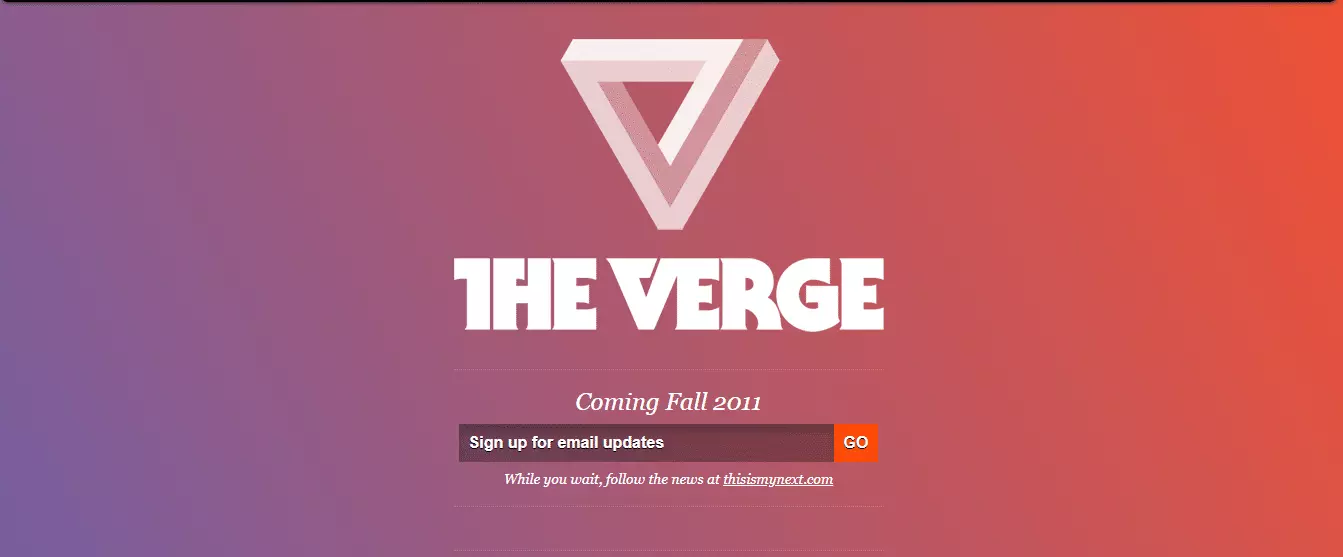
The Verge before its launch
Display Ads
The Verge started with 4M active users and 20 million page views in the first month (Src). The traffic had huge potential for monetization. The Verge team understood it and hence monetized the site right away with display ads.
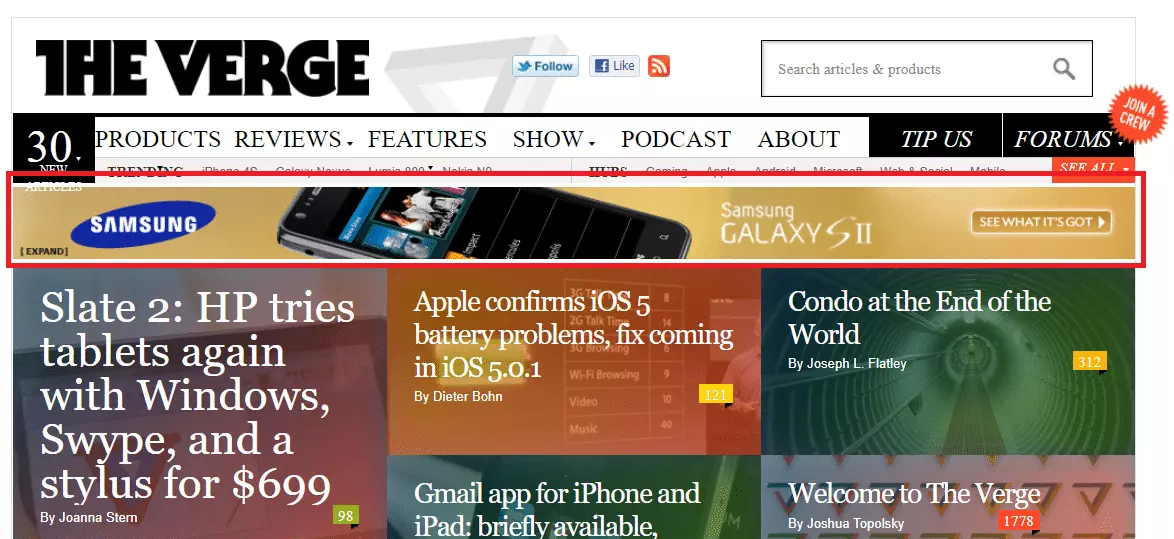
The existing infrastructure of SB Nation must have helped The Verge in bringing the premium demand to the site.
Story Streams
The Verge Started with a feature called “Story Stream”. This feature helped The Verge to go beyond the typical blog format. Multiple blogs (or stories) related to a single topic could be presented in a chronological order to provide a larger narrative to the users. The story page provided an overview of the topic followed by the chronologically organized stream of independent stories. The stories in the stream were carefully chosen by the editors, this made sure that only important and most relevant stories were being selected.
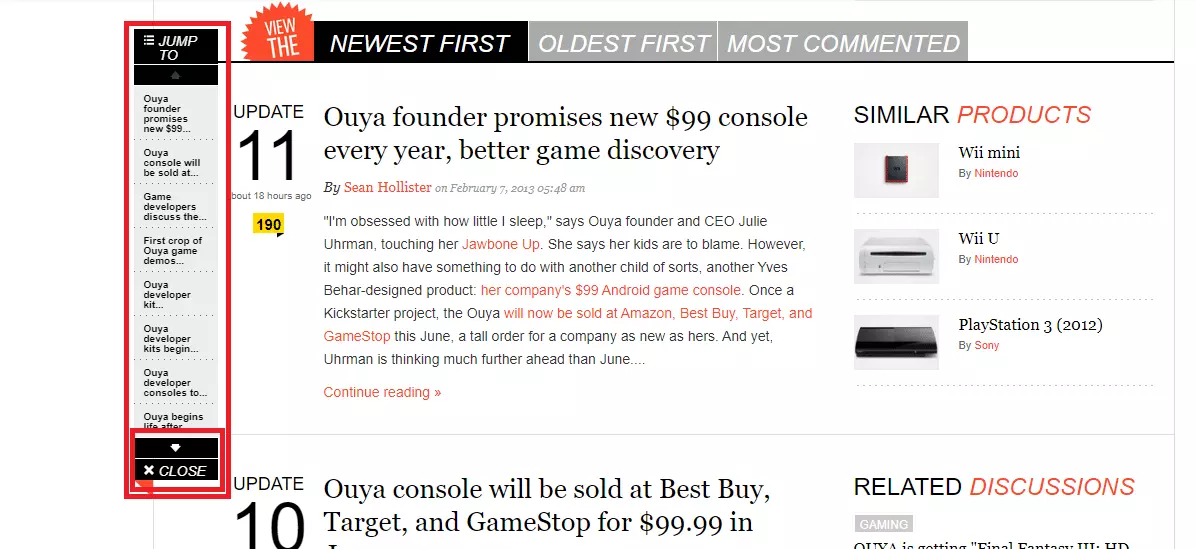
The users could navigate through the stream with the help of a panel. The stories too reminded the users that they are a part of a bigger narrative with the help of another panel on the right side.
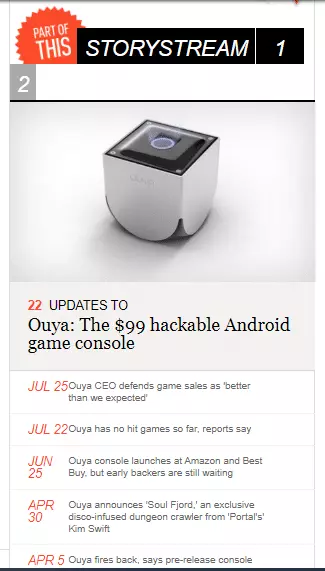
The users could bookmark the stream if they wished to stay informed about all the updates on a topic. The “Story Stream” feature provided an opportunity to – increase user engagement, increase pages per visit, increase dwell time, increase return visits, and motivate users to come directly to the site.
Podcasts
Vergecast and The Verge Mobile Show were launched along with the site. Vergecast became the flagship podcast from The Verge. It is still one of the top technology podcasts on iTunes. According to Nishat Kurwa, the Executive Producer of Audio of Vox Media (parent company of The Verge), “podcasting started as more of a hobby”(Src). But we can see that now it is a serious business for the publisher. Currently, The Verge lists 6 distinct podcasts on the site. It is worth mentioning that its parent company runs a podcast network that aims at generating a minimum revenue of $20M in 2020. (Src)
The strong focus on podcasts shows that the vision of the publisher was not limited to generating revenue on the site. It created a brand and then leveraged it to garner audiences on other platforms. Podcasts can be listened to freely on hundreds of free apps. It helped them to widen the reach manyfold. The sponsorship money generated by these podcasts helped the publisher in diversifying its revenue streams.
Video Content
On The Verge was a show launched as a web TV series. It was a talk show that focused on technology. It was the initial step The Verge took towards creating video content. Later on, The Verge created The Circuit Breaker Live and Mr. Robot Digital Aftershow that followed formats similar to the traditional TV shows. These shows cannot be considered monumental for The Verge but it kept evolving its video content strategy.
Now, The Verge creates not only regular tech reviews and opinions but also informational and educational videos. They are not only beautifully shot but they can have vibrant and smooth animations that are capable of captivating the viewers.
How did videos help? Going long on videos helped The Verge in earning ad revenue from channels like YouTube and Facebook. It also helped in tapping the audience that was more into watching videos than reading articles. Obviously, the videos also earned revenue through sponsorships. But now the publisher has taken its game of videos to the next level, its parent company is producing shows for Netflix (Src).
Chorus
One of the visions of the founders of The Verge was to provide modern and advanced technology to its content creators. For scaling up a publishing business, you need to create content faster than your competitors. For being faster, you need better tools. Chorus (a Content Management System) was used to provide this empowerment to The Verge’s writers and editors. Just like every other aspect of The Verge, Chorus also kept evolving with time. It enabled the editorial teams to work collaboratively. Stories could be written and edited simultaneously. Templates and designs were readily available in its powerful layout tool. Best suited titles and images could be selected algorithmically.
Chorus also took care of the technical sides of publishing. Distributing the content to multiple platforms, controlling the experience outside the website, SEO optimization, Chorus managed everything (Src)
Currently, the publisher has made the tool available for other premium publishers. It will even connect the publishers with advertisers through a marketplace that the publisher launched in 2016. The clients will be able to find sponsorships, programmatic advertising solutions and ad ops support too. The publishers have to pay a fee for using the tool. According to the Wall Street Journal, Chorus can generate six to seven-digit revenue per client.
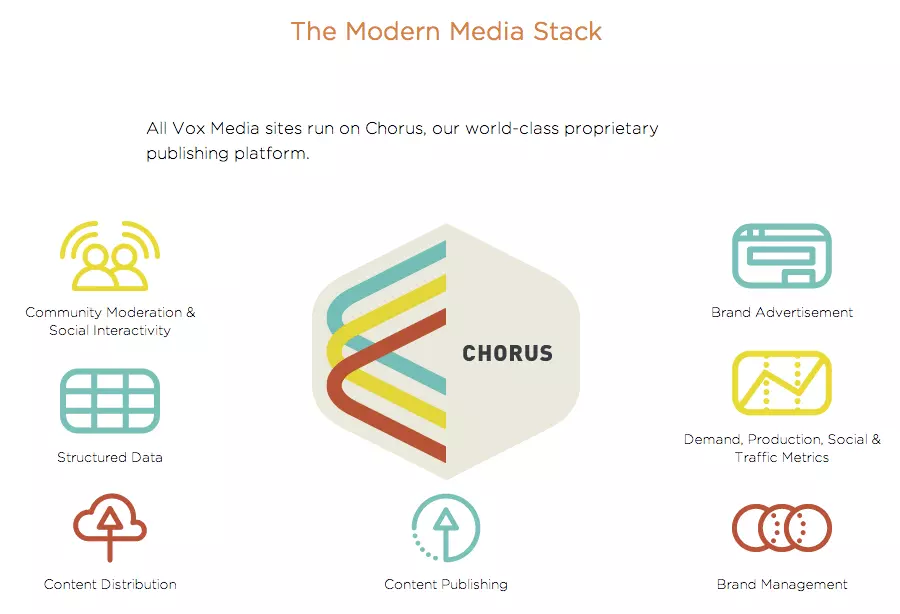
- Source: WNIP
By understanding and solving the difficulties of its editors, The Verge has not only succeeded in beating the competition, but it has also opened an additional revenue stream for its parent company.
Balancing Revenue and Experience
(2013-2016)
Walking an extra mile for the user experience
When The Verge was started it was very clear for the advertiser what kind of ads are to be avoided. “We don’t sell popups, roadblocks, interstitials, or anything that stops users or requires user interactions”, says Joe Alicata, former VP of Vox Media.
There was a strong focus on user experience. The company wanted to show the ads that perfectly suit the website. This was the reason why direct deals were the main preference of the company. It even had an in-house creatives team that used to manually build custom ads for the campaigns. Later the company created its proprietary tool called Hymnal that automated the process.
Hymnal was equipped with Creative Intelligence that enabled it to dynamically optimize ads based on user interactions. The tools could change or swap elements like background colors, photos, language, headlines, background images, calls to action, etc, and serve the combination that could yield the best results. Additionally, the company also worked on its technology to provide better targeting options to its buyers.
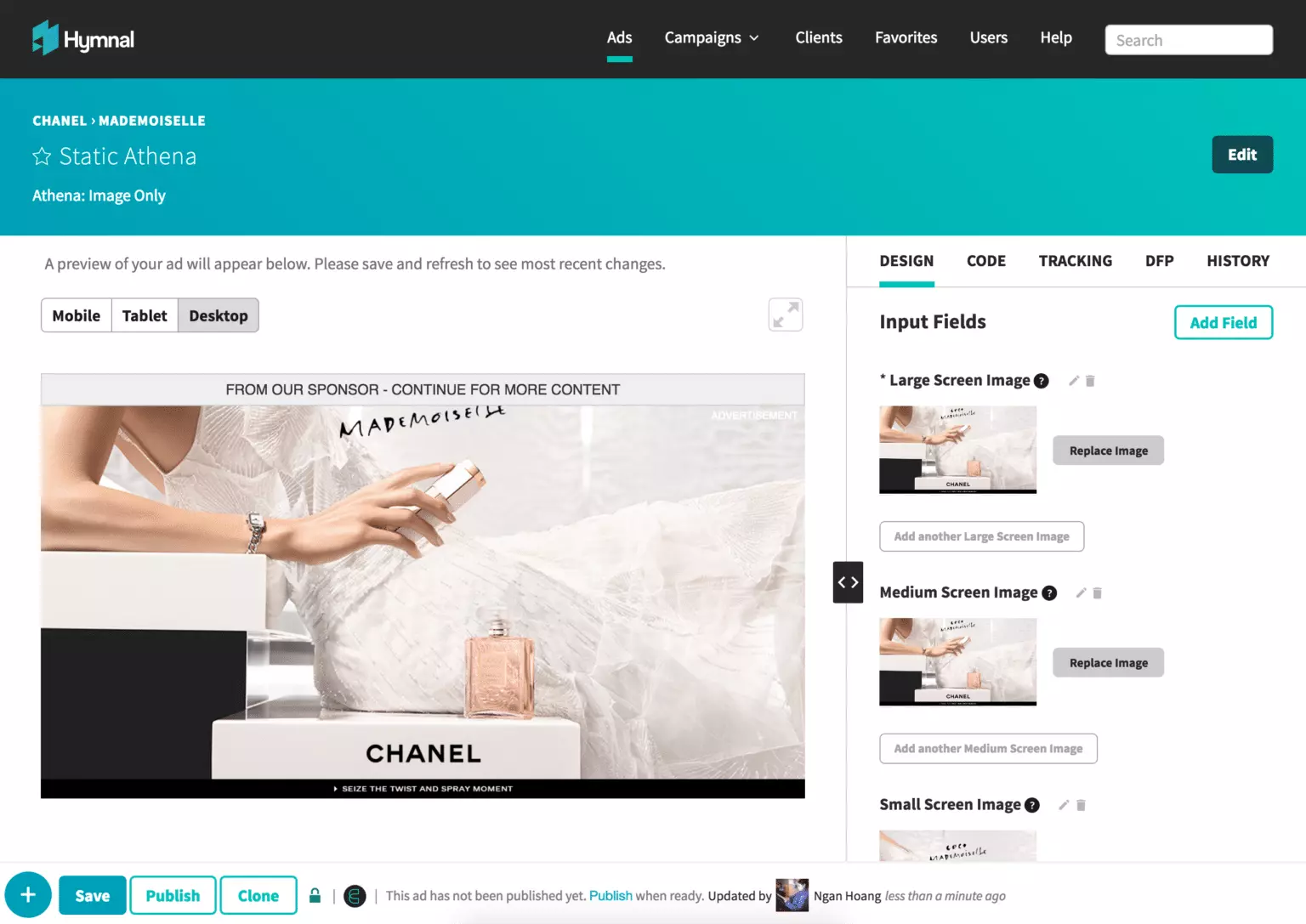
Ultimately the efforts paid off. The company claims that its technology can bring 12 times higher CTR with a 358% higher interaction rate when compared to the industry average (Src). In 2016, Digiday reported that the CPM on The Verge averages at $10.
An average publisher focusses on traffic and user experience is a secondary goal. But, The Verge teaches us how user experience is an equally important factor in generating revenue. By delivering the first-class experience, The Verge was able to enhance its user engagement to the top-notch level. The engagement later translated to soaring revenue. Every publisher should know how important UX is.
Embracing Programmatic
The Verge started with direct deals and followed the same ad selling model for a long time. In 2015 it embraced programmatic for the first time. The direct selling model was preserved but the implementation was done through programmatic direct. Private marketplaces and programmatic guaranteed campaigns were the chosen route for the direct deals. The Verge used Google DoubleClick (currently known as ad manager) for programmatic guaranteed deals and Pubmatic and Google AdX for private marketplaces. Programmatic brought automation in the ad selling process. With automation comes scalability. The Verge did not lose the perk of premium rates due to programmatic. PMPs and programmatic direct helped it in maintaining the level of ad prices.
Implementing header bidding increased its revenue further (Src). Header Bidding helped the publishers in a stronger competition among the advertisers in the Private Marketplaces. When the competition is strong then the advertisers bid higher to beat the competition, the revenue from the inventory increases.
It used Krux (now acquired by Salesforce) as its Data Management Platform. The use of the Data Management Platform provided further support needed to keep the rates intact. The DMP helped in discovering deeper insights about the audience which enabled the publisher for better targeting and personalization. Targeted ads have higher conversion rates and hence they yield more revenue.
Concert
Vox Media, the parent company of The Verge acted a lot like a tech company. The development of Chorus is one example and the launch of its ad network — Concert is another.
Once the company succeeded with its programmatic ads, it decided to graduate to the next level. Vox Media partnered with NBCUniversal to launch the Concert. In the beginning, only the inventory from Vox Media’s properties (including The Verge) and the properties of NBCUniversal were available to the advertisers. But just like always, the company had some bigger plans (Src).
In March 2017, Condé Nast also chipped in with its industry-leading data management solution called Spire. The addition of Spire brought new capabilities to Concert such as better behavioral targeting, online and offline purchase data to create a 360-degree view of the customer, and serving more personalized ads. The added inventory of Condé Nast also made the pool even bigger (Src).
By May 2018, Concert took its biggest leap. The New York Media, POPSUGAR, and Rolling Stone joined hands with Vox Media. The new entrants, along with the existing premium publishers like Penske Media Corporation, Funny Or Die, The Ringer, Brit + Co, Flipboard, and Entrepreneur enabled Concert to reach 90% of all internet users in the USA (Src).
Such a huge pool of premium inventory was enough to make premium buyers flock around. The increasing competition among the buyers also increased the ad prices and The Verge was a direct beneficiary.
Building a Brand
(2016 – Present)
The Big Makeover
On its 5th birthday, The Verge brought a big makeover to the site. The Publisher redesigned the logo, changed the design of the home page with better aesthetics, easier navigation, and more headlines. New article pages were introduced. The style of photography on the site was changed, etc. But the most important of them all was the new design system.
The design system was named pathways. It was applied to the entire user interface of the site and it was even adaptable in the animations of its videos. It worked as a visual language and every element related to The Verge started speaking the same language.

If you do not know what a design system is then let us explain it to you. A design system is a consistent theme which a company follows throughout its visual elements. In the case of The Verge, these elements were the fonts, lines, the typefaces, the colors, etc. The Verge followed the same theme for its UI, social media posts, videos, and everything visible to the users.
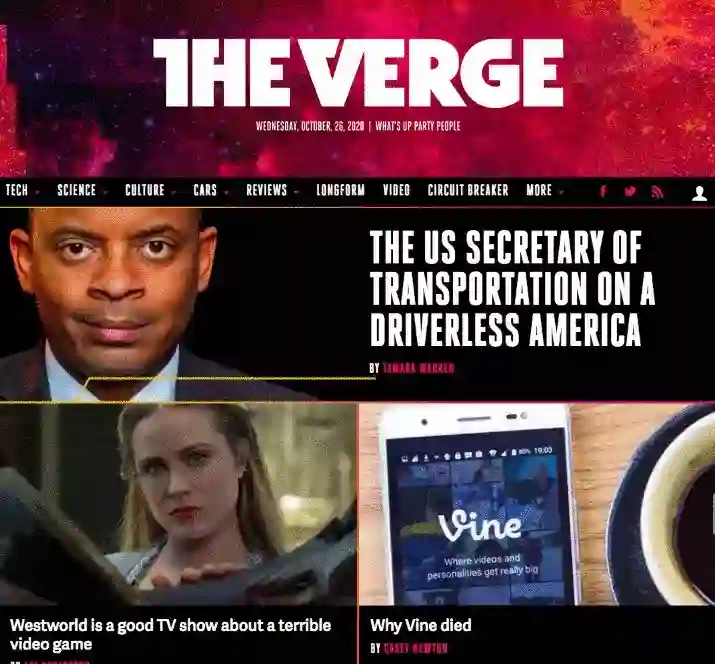
How did it help? By using a consistent theme across all its content on and outside the website helped in building a strong visual identity. Having a distinct identity is important if you want your users to return to you, especially in a crowded market. It makes you recognizable, helps you in creating a strong image, and gaining loyal followers. The Verge also gained the same benefits. It made its position stronger as a premium publisher. It carved its unique style, so any user who likes The Verge’s style will always return to it.
Building a brand is probably the least important objective in the mind of an average publisher. But The Verge shows that you have to be different if you want to avoid getting lost in the crowd of your competitors.
The Verge Science
The Verge was already covering science topics since its inception, but in 2018 the science section was branched out as a separate entity on YouTube. The new channel brought the opportunity to gain the audience that is interested only in science-related topics. Currently, the channel has almost a million subscribers (Src).
To grow the channel faster, The Verge implemented a number of strategies. The videos always have a question in them to encourage the audience to answer those questions through comment and increase engagement. It also availed behind the scene videos to the viewers so that the audience is spending more time with the channel. The behind the scene videos were kept unlisted, which means these videos could be watched only by the users who had the link to them. This strategy created a “movie easter egg” kind of scenario and helped the channel to make the viewers revisit. The links to the hidden videos were distributed via community tab, comments section, and end screens of the visible videos. So in a way, they were mostly found by the users who were highly engaged with the channel.
Later, The Verge also started creating episodic content. It aimed to create videos that can later be packaged together to form a series that can be sold to streaming platforms or TV Networks. We’ve already mentioned earlier that the publisher now makes a web series for Netflix, which means that the publisher succeeded in achieving the goal.
So, this experiment of The Verge helped it in two ways. First, it helped in gaining more audience that shared a strong common interest, ie Science. Second, it helped them to scale the video business beyond YouTube and its ad revenue. It made them a stronger media brand. It’s needless to say that The Verge Science generated sponsorship revenue too.
Conclusion
There are many lessons that a publisher can learn from The Verge. The first lesson is about scaling up. ‘This Is My Next’ scaled up to The Verge itself. Podcasts scaled up to a podcast network. Its Content Management System scaled up to a Software as a Service business. The videos scaled up to the web series business. Just like The Verge, every publisher should have a vision of scaling up each and every aspect of his current publishing business.
Another big lesson that The Verge teaches us is that your attention to detail can take your publishing business to the next level. Being precise about how the ads should and should not look like on the site helped it in bringing up its revenue. Building a brand by harmonizing every element of its properties helped it in creating authority in a crowded market. It focussed on smaller things that can make them a bigger publisher.
Experimenting also helped The Verge a lot. It kept doing what was not being done by other publishers. The Story Stream feature helped it in going beyond blogs. Podcasts were started as a hobby that translated into a business opportunity. Hiding some videos brought increased engagement. The Verge did not shy away from doing non-traditional activities and to find more ways to grow itself. Every publisher should learn that taking risks and experimenting can take you to places.
“Consumer technology made sense for a lot of reasons. There are a lot of similarities between sports and technology, starting with the fact that the advertisers have a lot of overlap – it’s a majority male demographic. And it made sense from the content perspective, with these same structured data elements: in sports, you have stats, players, teams, and in tech, you have specs, gadgets, manufacturers, and devices.”
– Jim Bankoff (Business Insider).
The biggest lesson that The Verge teaches us is about vision. It was started by SB Nation, a sports publisher, and the founders already had the vision of becoming a media company. Visionaries are in constant hunt of opportunities. It was the vision that helped CEO Jim Bankoff to spot the opportunity in the tech niche.























